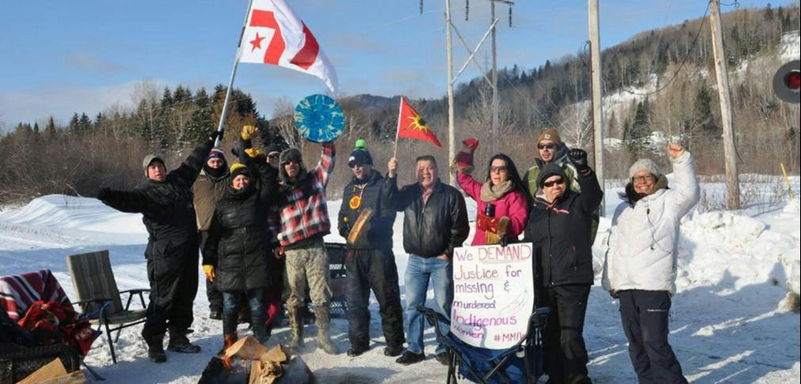Like this article? Chip in to keep stories like these coming.
Now that we have had some time to reflect on the #ShutDownCanada demonstrations, I think there are some important lessons to be learned or re-learned by veteran activists who think they know all the old tricks.
Let’s just start with the principles of honesty, and I say this after receiving some angry hate mail from some readers who felt that my lack of support for ShutDownCanada meant that I was rejecting the principles of Indigenous solidarity or Idle No More. What I was bringing attention to was not the unworthiness of the action, but the tactic of online organizing.
I know that ShutDownCanada was taken by some to be an Indigenous-led action that was supposed to trigger blockades of highways, railways, ports and our international borders. As the date grew closer, more and more people clicked “like” or “join” over Facebook and the day received some pre-emptive mainstream media coverage. These were all good signs that there would be a robust action on February 13, 2015.
This is at least what the original call out spoke of:
“CALLOUT for communities across Canada to blockade their local railway, port or highway on February 13. Don’t buy, don’t fly, no work and keep the kids home from school. A diversity of tactics is highly recommended! Get everyone involved. The goal is to significantly impact the Canadian economy for a day and demand there be an independent inquiry into the 2000+ cases of missing or murdered indigenous women. It’s Time to #ShutDownCanada.“
As well as the premise of No Business As Usual, the focus was to be on demanding that the Conservative government call an independent inquiry into the high number of murdered and missing Indigenous woman.
While I 100 per cent agree with this goal, I had some serious issues regarding tactics.
Let me be clear: Facebook — or any online medium — is not the place to be discussing political or protest tactics. I’m not saying don’t discuss politics or ideologies, but tactics is a whole other matter.
As members of radical communities, we need to constantly be aware of security culture. And this means protecting ourselves from online surveillance — as there is proof that the government is keeping an eye on Indigenous activists like Clayton Thomas-Mueller.
This surveillance has been ongoing since 2007 when the Harper government first established a national and international police surveillance network — via the Royal Canadian Mounted Police (RCMP) — to keep tabs on the politics of Indigenous communities and their allies. These “Communities of Concern” are people in communities trying to protect their traditional territories from destruction and their culture from annihilation.
In fact, back in 2011, Defenders of the Land‘s spokesperson, Arthur Manuel, released the following statement condemning police surveillance of communities and the criminalization of dissent, “They are not extremists or terrorists. All of their protests or political actions were in defense of their constitutionally recognized and internationally affirmed right of self-determination and land rights as Indigenous Peoples.”
With this heavy on my mind, I feel veteran activists have let down the younger generation of activists in not passing down our vigilance regarding police surveillance. In fact, anyone need not look further than the criminalization of activism and organizers that occurred before and after the G20 demonstrations in Toronto in 2010 where various members of the activist community in Southern Ontario spent multiple months in prison, including stints in solidarity confinement.
Now getting back to ShutDownCanada, this initiative mostly lived and spread online with little to no face-to-face contact meetings between activists (Vancouver excluded here as their shut the port action had several planning meetings and obvious, was thus the most successful of the ShutDownCanada rallies).
And I feel it was this lack of face-to-face relationship and community building that failed to bind the ShutDownCanada action to a political movement. Online commitment to attend an action is very different than personal accountability.
In some cities, literally no one or one or two people showed up and there were people posting to the various Facebook pages asking where all the people who had signed up had gone . Here is a pretty unflattering article about what occurred in Regina.
Another issue was timing.
Some Indigenous community members felt the timing of February 13 was a crass move since the day before was the annual–sometimes going on for twenty years in British Columbia–vigil for murdered and missing Indigenous women.
The fear was that the ShutDownCanada event the day before would, steal the thunder of the established Indigenous-led vigils that take place across Canada and the United States every year. A reporter for the Toronto Media Coop informed the ShutDownCanada Toronto organizers that leadership from Six Nations were not willing to endorse the demonstration and were actively encouraging people to not attend on February 13 and put their focus instead on the time-honoured vigils the day after.
After all, the event on February 13 stated aim was to bring attention to the, “2000+ cases of missing or murdered indigenous women” which is exactly the focus of the February 14 vigils.
So maybe part of the friction, too, was a matter of tactics. Calling for a vigil is a very different thing than calling for the total shutdown of business as usual in Canada.
Image: Twitter/@TriniaRoache




